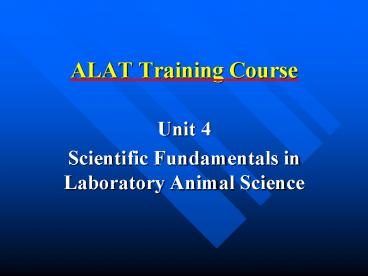ALAT Training Course - PowerPoint PPT Presentation
1 / 34
Title:
ALAT Training Course
Description:
ALAT Training Course Unit 4 Scientific Fundamentals in Laboratory Animal Science Animal Rooms Conventional No special precautions are taken to prevent the ... – PowerPoint PPT presentation
Number of Views:279
Avg rating:3.0/5.0
Title: ALAT Training Course
1
ALAT Training Course
- Unit 4
- Scientific Fundamentals in Laboratory Animal
Science
2
Animal Rooms
- Conventional
- No special precautions are taken to prevent the
introduction of disease into the colony - Barrier
- Special cages and procedures, like sterilizing
bedding and use of filtered air in the rooms
3
Animal Rooms
- Macroenvironment
- Temperature (64-79º F or 18-26ºC)
- Ventilation (10-15 fresh-air changes/hr)
- Light intensity and duration (325 lux or 30-ft
candles measured at 1 m or 3 ft from off the
floor) - 1212
- 1014 (breeding colonies)
- Humidity (30-70)
- Noise ( gt 85 dB causes stress responses)
- Other variables
4
Animal Rooms
- Microenvironment
- Cage level environment
5
(No Transcript)
6
Bedding
- Availability
- Non-nutritive
- Absorbency
- Nontoxicity
- Comfort
- Disposability
- Uniform size
7
Temperature
8
Humidity
9
Ventilation
- Air balance is checked with an anemometer
- Positive Pressure
- Opening a door in a positive pressure room causes
the air in the room to flow out toward the
hallway (keep things out - bioexclusion) - Negative Pressure
- Opening a door in a negative pressure room
causes air the hallway to flow into the room
(keep things in - biocontainment)
10
Animal Room Construction
- Easy cleaning
- Nonslip, waterproof floors
- Slotted drain covers
- Floors sloped toward drains
- Walls and ceilings made of sealed concrete
- Surfaces frees of cracks and chipped paint
- Recommended door dimensions are 42 x 84 inches
11
Facility Security
- Computerized card system
- Sign-in/sign-out log for visitors
12
Animal Facility Areas
- Cagewash
- Quarantine, conditioning, isolation areas
- Feed and bedding storage
- Equipment storages
- Personnel areas
- Procedure rooms
- Emergency backup power
13
Hazardous Agents
- Research may involve the use of materials or
procedures that present a physical, chemical,
biological (biohazard) or radiological hazard to
staff and laboratory animals
14
Dead Animal Storage and Disposal
15
Caging Materials
16
Microisolation System
17
Hooded microisolation workbench
18
(No Transcript)
19
Primate Caging
20
Gang Cages
21
Transport Cages
22
Feeding and Watering Accessories
J-shaped feeder
23
Automatic Watering System
24
Cagewashing Equipment
25
Cage and bottle washer
26
Hygiene in the Laboratory Animal Facility
- Sterilization
- Destruction of all organisms on an object
- Disinfection
- Reduction of the number of pathogenic
microorganisms on an object to a harmless level - Sanitation
- Reduction of number of microorganisms on a an
object to an acceptable public health standard
27
Sterilization
Time 15 min Temp 250ºF Pressure 15 lbs/sq in
(psi)
Autoclave
28
Disinfection
- -cidal
- A disinfectant with killing action
- -static
- A disinfectant that inhibits microorganism growth
29
Disinfection
- Commonly use chemicals
- Phenols
- Sodium hypochlorite (bleach)
- Quanternary ammonias
30
Sanitization
- Chemical Handling Guidelines
- Store chemicals in cool, central area
- Follow the instructions on the label
- Never use a container that is not labeled
- Never mix two chemicals together unless directed
by the manufacturer to do so - Do not accept product samples unless they will be
evaluated quickly
31
Cage Changes
- to provide a healthy environment for an animal,
in accord with its normal behavior and
physiologic characteristics
32
Hygiene in the Laboratory Animal Facility
- Animal Equipment Cleaning Techniques
- Animal Room Cleaning Schedules and Techniques
- Other Equipment Changes
- Environmental Monitoring
- Vermin Control
33
Personal Safety and Hygiene
- Protective Clothing
- Footwear
- Ear Protection
- Eye and Face Protection
- Face Masks
- Uniforms
- Gloves
34
Personal Hygiene Practices
- Store and consume food, candy, gum and beverages
only in designated areas of the facility - Keep hands away from face
- Keep personal items in designated areas
- Always wash hands before leaving the animal
facility - Wash hands after removing dirty protective
clothing - Bring to the attention of your supervisor any
situation jeopardizes good hygiene






























